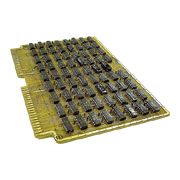In October 1966, NEC completed the NEAC Series 2200 Model 500, a large computer which was the first Japanese produced machine to use monolithic integrated circuits (ICs) throughout the system. CTL (Complementary Transistor Logic) was used for the ICs, thus reducing the size of the system to one third to one sixth the size of equipment using discrete components, and improving reliability by more than 10 times. Various new features were added, in addition to the features available with the NEAC Series 2200 Model 50, M100, M200, M300 and Model 400, and the machine was developed as a central processing unit suitable for large-scale IDP (Information Data Processing) system and real-time systems. In the Model 400 and lower, the main memory unit was accessed character by character, but with the Model 500, 8 characters could be accessed simultaneously with a 1.5-microseconds cycle time, and this improved the effective memory cycle time from the viewpoint of the logic unit. Instruction look-ahead control and simultaneous control systems were incorporated throughout, and interrupt capabilities were enhanced. Maximum memory capacity was 524,288 characters, and floating point division speed was 18.0 microseconds.

- Home >
- Historical Computers in Japan >
- Mainframes >
- NEAC Series 2200 Model 500
All Rights Reserved, Copyright (C) Information Processing Society of Japan


